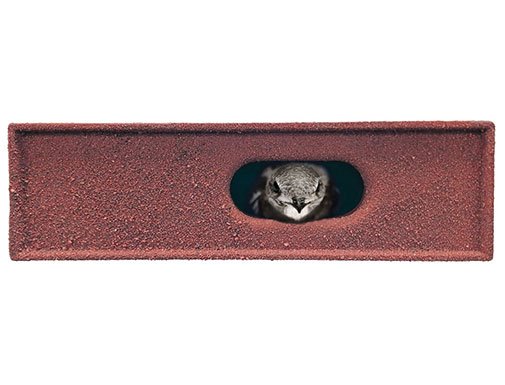Other Swift and Bee Products
Manthorpe Dual Swift Brick
The Manthorpe Dual Swift Brick has been developed in conjunction with conservation experts, including our own Dick Newell, to provide a safe, spacious and habitable area for swifts. The design of the Dual Swift Brick allows it to work with cavity walls of 100mm or 50mm, making it ideal for modern timber frame constructions. With a double-brick granular plastic front available in buff or antique red, the Manthorpe can be installed either way round to provide left or right hand entrances.
-
Takes the place of two bricks, with the coloured faces blending into the surrounding masonry.
Variant front slip option available for use with rendered walls, including entrance hole former.
Ambidextrous design can be installed with either left or right hand entrance.
Neat and simple to install, can be fitted quickly during the bricklaying or retrospectively afterwards.
The integral nesting cup provides an ideal starting point for nest building.
500cm2 of floor area gives the maximum habitable living space within the wall construction
We recommend the Manthorpe Dual Swift Brick where there is no requirement to match the external brick work and where a plastic product is suitable. For situations where a fireproof brick is required, we would recommend the AfS S-Brick
Weight: 0.68kg.
L 440mm, D
-
The Swift Brick should be located high within the gable wall of the property, ideally above 4 metres high and over the level of the insulation zone. Where possible, install in locations that are unlikely to receive large amounts of direct sunlight during the hottest times of the day, ideal places include below the overhang of the verge and barge board.
There is no ‘wrong way up’ for the Dual Swift Brick, the unit can be fitted either way up to allow the entrance hole to be sited on the left or right hand side, allowing it to be tucked closely under the verge.
PLEASE ADOPT APPROPRIATE SAFETY MEASURES WHEN INSTALLING THIS PRODUCT AT THE RECOMMENDED HEIGHT
-
-
To get a quote please enquire below.
Solitary Bee Bricks
In the UK there are over 200 species of solitary bee, in fact they comprise 90% of our native bees.
They are incredibly important to our ecosystems as pollinators, but pesticide use and loss of habitat has put them at threat.
They are attracted to our gardens because of the nectar bearing flowers and plants. These bricks provide nesting holes for the female to lay her eggs. AfS Bee Bricks have a hole depths of up to 145mm, taking into account the bees requirement to lay female eggs at the back of the hole and male eggs towards the front.
Solitary bees are largely harmless and are safe to encourage into our gardens, with a very mild sting that they rarely use.
We strongly recommend the annual cleaning of AfS Bee Bricks to remove debris, parasites and mould.
We provide a small brush with every brick to help you do this.
-
Dimensions 215mm x 195mm x 65mm
Weight 2.5 kg (unpackaged)
The AfS bee brick should be positioned in a warm sunny spot, south facing, with no vegetation in front of the holes. Ideally they should be placed around 1m from the ground.
How bees use nesting cavities.
Many bees are solitary, with each female creating her own nest, and prefer to use pre-existing holes rather than drilling their own. In addition to walls, they also use hollow plant stems, dead wood, or burrows in the ground.
A solitary female bee will typically follow this process for nesting:
1. Preparation: After selecting a deep nesting cavity, she creates several individual chambers, or cells, inside the tunnel by constructing a wall of mud or other material.
2. Laying female eggs: At the very back of the tunnel, she lays fertilized eggs, which will develop into female bees. Since females are more valuable to the next generation, she places them at the most protected end of the nest.
3. Laying male eggs: She then lays unfertilized eggs, which become male bees at the front of the tunnel. Males emerge first in the spring, allowing them to be ready to mate with the newly emerging females.
4. Sealing the nest: Finally, she seals the entire tunnel to protect the brood. If the cavity is too shallow, she will lay more male eggs and fewer female eggs.
The significance of hole depth
The optimal depth for a nesting hole is longer than most bee bricks can provide. If the tunnel is too short, the bee's production of female offspring can be reduced (Seidelmann et al 2016).
We have designed the AfS Bee Brick to be the maximum depth available that fits within a 50mm cavity and it contains holes with a depth of up to 145mm.
The depth also provides:
• Space: Enough room for a series of separate brood cells.
• Protection: Better insulation and a barrier against predators and parasites.
• Winter survival: Protection for the larvae as they develop over the winter.
You should clean bee bricks to prevent the build-up of parasites, debris, mould, and predators like spiders and wasps, which can harm the larvae, as the natural process of a decaying tree leaving a new site does not happen in a fixed bee brick.
Cleaning involves removing old nesting material and emptying the cavities, ideally in October when nests are known to be full, failed, or empty, to provide a clean, healthy nesting site for new bees the following spring. Every AfS Bee Brick is supplied with a cleaning brush!
It comes in a range of colours. We can make this bespoke, but where your brick is not suitable we will find a close match in colour and texture.
-
Description text goes here
-
Please enquire below and we can provide you with a quote






